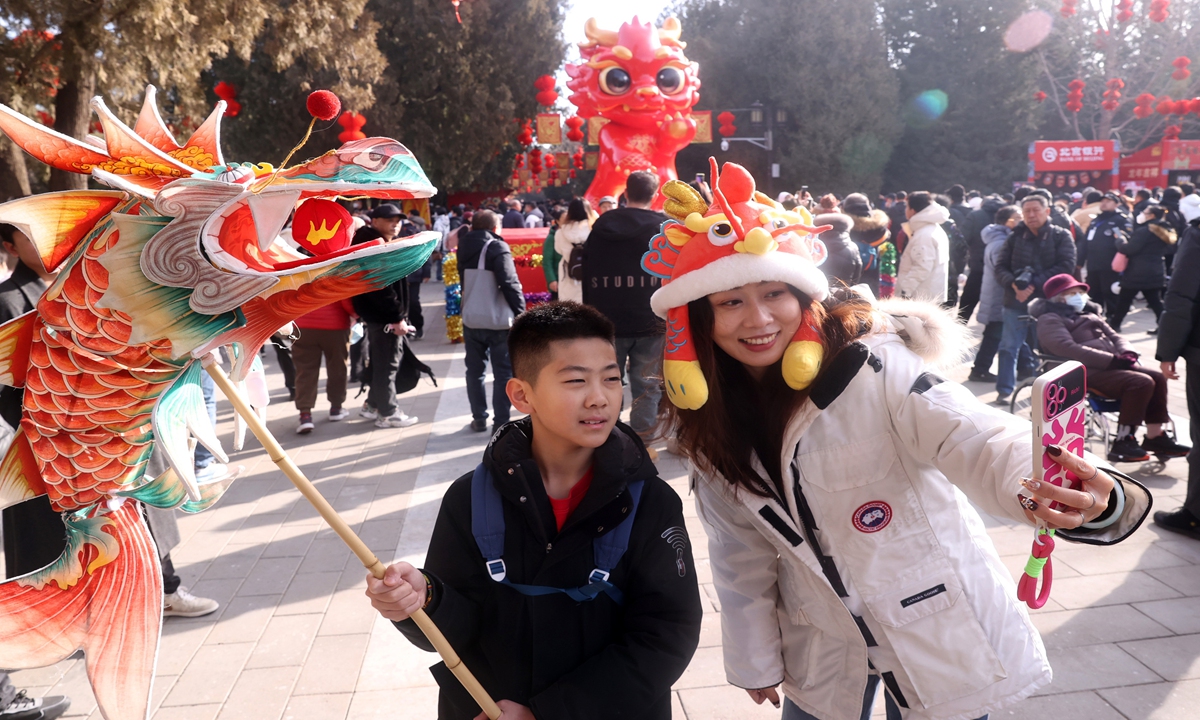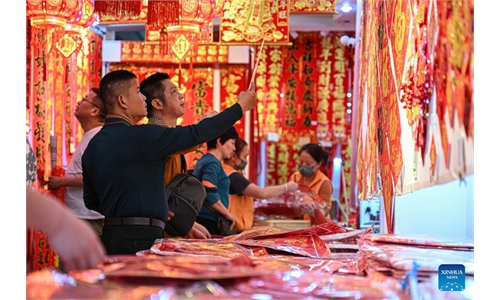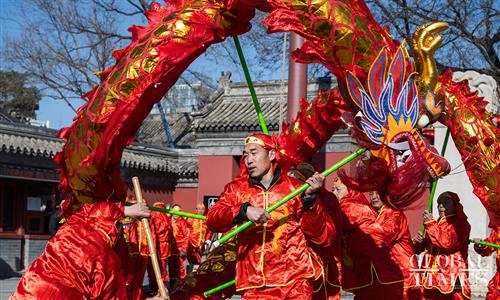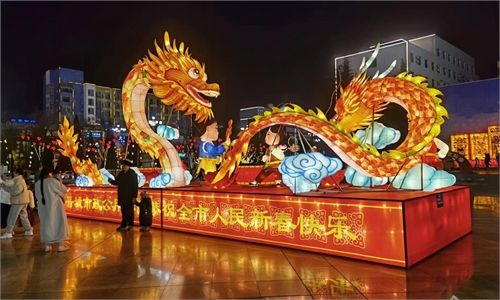Hometown witness: Return of traditional temple fairs brings ‘old Beijing’ back, demonstrating vitality of city, inheritance of culture

Tourists take a photo with a dragon lantern against the backdrop of "Longlong," the zodiac mascot of the Ditan temple fair, at Ditan Park in Beijing on February 11, 2024. Photo: VCG
Traditional temple fairs in Beijing made a big comeback this Spring Festival, after being put on hold for four years because of the pandemic. The Global Times reporters visited the temple fair during the holiday in person and were deeply shocked by its popularity and strong festival atmosphere.
On February 11, which was the second day of the Chinese Lunar New Year, a Global Times reporter witnessed bustling crowds of tourists gathered at the entrance of Beijing's Ditan Park (the Temple of Earth). The day also marked the opening of the 36th Ditan Spring Festival cultural temple fair and the return of the temple fair after a four-year hiatus.
This edition of the Ditan Park temple fair featured four performances, five thematic photo exhibitions, five interactive experiences, and two charity events, with the main focus on inheriting traditions and experiencing folk customs, the Global Times reporter learned.
Streets and alleys were adorned with colorful lights, bustling temple fairs were being held in parks, and innovative ideas were emerging in major business districts. Beijing, as the capital of the country and a city renowned for its historical and cultural significance, has served up a rich feast of Spring Festival cultural activities.
It took about 20 minutes for the Global Times reporter to buy a ticket for the temple fair as the queue was so long, and the area was packed with visitors. The reopening of the temple fair added to the festive atmosphere while also bringing considerable traffic pressure to the roads. It took about 30 minutes for the reporter to park the car and walk into the park.
However, the excitement was palpable. A visitor from Changchun city in Northeast China's Jilin Province surnamed Sun told the Global Times that she was so happy to see the hustle and bustle of the "old Beijing" is back, as there are many traditional cultural activities staged at the temple fair. "This not only demonstrates the vitality of a city, but also shows the inheritance of culture," she said.
At the Ditan Park temple fair, the reporter noted a variety of trendy novelties such as handmade lanterns resembling fish turning into dragons, cute and lovely dragon-shaped hats, and vibrant dragon-themed dance performances... Alongside these, there were also many intangible cultural heritage products, exuding a rich traditional flavor and a strong cultural atmosphere. In the amusement area, there was a wide range of interactive games available for visitors to immerse themselves in the festive atmosphere while strolling through the fair.
The Global Times reporter also saw some foreigners visiting the Ditan temple fair, taking some lovely dragon-shaped hats as souvenirs.
At the Fangze Altar in the park, which is the best-preserved piece of architecture used for worshipping the God of the Earth, the audience was packed, eagerly awaiting the grand performance resembling Qing Dynasty (1644-1911) rituals to begin. Many visitors who came from afar not only to experience the traditional Chinese Lunar New Year atmosphere of old Beijing but also to relive the profound affection ancient people had for the land and their reverence for ritual culture.
The same popularity was also felt by another Global Times reporter when visiting the Longtan temple fair on February 16. Surprisingly, despite it being the last day of the fair, visitors continued to arrive in an endless stream. Even from several tens of meters away from the park gate, the reporter could already see the long queue forming at the entrance.
As one of the famous temple fairs in Beijing, this year's Longtan temple fair highlighted the organic integration of traditional folk culture and trendy culture. Not only traditional crafts such as diabolo and Chinese papercut were showed at the fair, new activities like e-sports were also on show to enhance visitors' engagement through immersive interactive experiences.
The Global Times reporter also noticed that stalls selling various traditional Beijing snacks all had long queues, with tourists trying out different kinds despite the cold winter, and some snacks were even sold out due to their popularity.
"The Beijing snack that left the deepest impression on me is definitely fried sausage. It has a crispy exterior and tender inside, topped with saltwater and garlic sauce, which tastes the same as before," a tourist surnamed Wang in his 60s, who was a native Beijinger, told the reporter.
Wang shared with the Global Times that he was very happy to hear the news that the temple fair returned, as it was a great opportunity for the people to visit the temple fair with their families during the Spring Festival. "Especially, it was the first time in four years that the traditional temple fair is being held again, which shows the common aspiration for the people to have a joyful and peaceful holiday and hope for a better life in the coming year," Wang said excitedly.
According to official statistics, during the Spring Festival holidays, propelled by the return of traditional temple fairs and the enrichment of cultural tourism activities in Beijing, the holiday tourism market witnessed a strong surge in popularity. Several indicators reached historic highs, surpassing the overall popularity of the Mid-Autumn Festival and National Day holidays in 2023.
Visiting the traditional temple fairs has become the top choices for the holidays. The enthusiasm of citizens and tourists soared, with Longtan temple fair attracting over 140,000 visitors on the first day of the Chinese Lunar New Year and the Ditan Park temple fair greeting more than 220,000 visitors on the second day. Throughout the holidays, these park fairs collectively welcomed 5.164 million visitors, the Beijing News reported on Saturday.
At the Baiyun (White Cloud) Temple, which is one of China's major Taoist temples, many visitors came to touch the stone monkey and toss coins from the Wofeng Bridge. As the old Beijing saying goes, it is believed that touching the stone monkey at the temple can ward off disasters and bring blessings. Therefore, every year during the Spring Festival temple fair, many visitors line up in long queues to touch the stone monkey.
Observers noted that the popularity of the return of traditional temple fairs in Beijing shows the enduring charm of traditional culture and the capital's growing vitality, reflecting the public's confidence in a better future.




